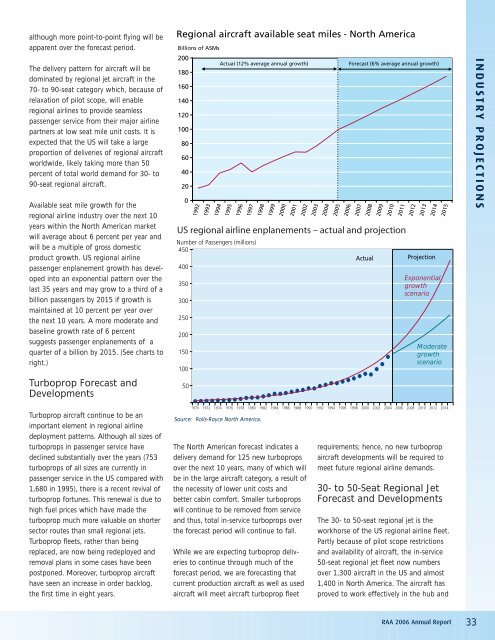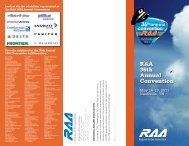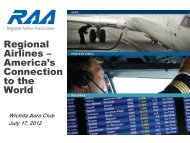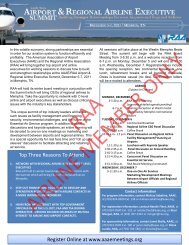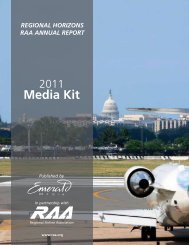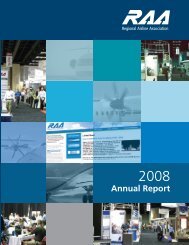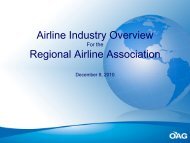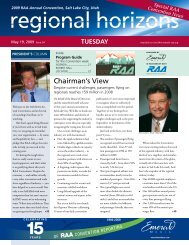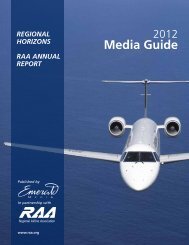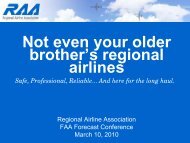Right time. - Regional Airline Association
Right time. - Regional Airline Association
Right time. - Regional Airline Association
Create successful ePaper yourself
Turn your PDF publications into a flip-book with our unique Google optimized e-Paper software.
although more point-to-point flying will be<br />
apparent over the forecast period.<br />
The delivery pattern for aircraft will be<br />
dominated by regional jet aircraft in the<br />
70- to 90-seat category which, because of<br />
relaxation of pilot scope, will enable<br />
regional airlines to provide seamless<br />
passenger service from their major airline<br />
partners at low seat mile unit costs. It is<br />
expected that the US will take a large<br />
proportion of deliveries of regional aircraft<br />
worldwide, likely taking more than 50<br />
percent of total world demand for 30- to<br />
90-seat regional aircraft.<br />
Available seat mile growth for the<br />
regional airline industry over the next 10<br />
years within the North American market<br />
will average about 6 percent per year and<br />
will be a multiple of gross domestic<br />
product growth. US regional airline<br />
passenger enplanement growth has developed<br />
into an exponential pattern over the<br />
last 35 years and may grow to a third of a<br />
billion passengers by 2015 if growth is<br />
maintained at 10 percent per year over<br />
the next 10 years. A more moderate and<br />
baseline growth rate of 6 percent<br />
suggests passenger enplanements of a<br />
quarter of a billion by 2015. (See charts to<br />
right.)<br />
Turboprop Forecast and<br />
Developments<br />
Turboprop aircraft continue to be an<br />
important element in regional airline<br />
deployment patterns. Although all sizes of<br />
turboprops in passenger service have<br />
declined substantially over the years (753<br />
turboprops of all sizes are currently in<br />
passenger service in the US compared with<br />
1,680 in 1995), there is a recent revival of<br />
turboprop fortunes. This renewal is due to<br />
high fuel prices which have made the<br />
turboprop much more valuable on shorter<br />
sector routes than small regional jets.<br />
Turboprop fleets, rather than being<br />
replaced, are now being redeployed and<br />
removal plans in some cases have been<br />
postponed. Moreover, turboprop aircraft<br />
have seen an increase in order backlog,<br />
the first <strong>time</strong> in eight years.<br />
<strong>Regional</strong> aircraft available seat miles - North America<br />
Billions of ASMs<br />
200<br />
180<br />
160<br />
140<br />
120<br />
100<br />
80<br />
60<br />
40<br />
20<br />
0<br />
Actual (12% average annual growth) Forecast (6% average annual growth)<br />
1992<br />
1993<br />
1994<br />
1995<br />
1996<br />
1997<br />
1998<br />
1999<br />
2000<br />
2001<br />
2002<br />
2003<br />
2004<br />
2005<br />
2006<br />
2007<br />
2008<br />
2009<br />
2010<br />
2011<br />
2012<br />
2013<br />
2014<br />
2015<br />
US regional airline enplanements – actual and projection<br />
Number of Passengers (millions)<br />
450<br />
400<br />
350<br />
300<br />
250<br />
200<br />
150<br />
100<br />
50<br />
1970 1972 1974 1976 1978 1980 1982 1984 1986 1988 1990 1992 1994 1996 1998 2000 2002 2004 2006 2008 2010 2012 2014<br />
Source: Rolls-Royce North America.<br />
The North American forecast indicates a<br />
delivery demand for 125 new turboprops<br />
over the next 10 years, many of which will<br />
be in the large aircraft category, a result of<br />
the necessity of lower unit costs and<br />
better cabin comfort. Smaller turboprops<br />
will continue to be removed from service<br />
and thus, total in-service turboprops over<br />
the forecast period will continue to fall.<br />
While we are expecting turboprop deliveries<br />
to continue through much of the<br />
forecast period, we are forecasting that<br />
current production aircraft as well as used<br />
aircraft will meet aircraft turboprop fleet<br />
Actual<br />
Projection<br />
Exponential<br />
growth<br />
scenario<br />
Moderate<br />
growth<br />
scenario<br />
requirements; hence, no new turboprop<br />
aircraft developments will be required to<br />
meet future regional airline demands.<br />
30- to 50-Seat <strong>Regional</strong> Jet<br />
Forecast and Developments<br />
The 30- to 50-seat regional jet is the<br />
workhorse of the US regional airline fleet.<br />
Partly because of pilot scope restrictions<br />
and availability of aircraft, the in-service<br />
50-seat regional jet fleet now numbers<br />
over 1,300 aircraft in the US and almost<br />
1,400 in North America. The aircraft has<br />
proved to work effectively in the hub and<br />
RAA 2006 Annual Report 33<br />
INDUSTRY PROJECTIONS


